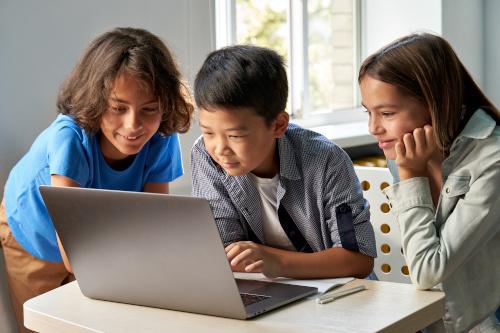(Editor’s note: This article is the first in a three-part series about how school systems can build on the progress and leverage the investments they’ve made in technology during the pandemic to achieve true digital transformation. Part 1 looks at how K-12 leaders can build an effective blueprint for redesigning education in a way that’s more equitable, meaningful, and learner-centered. Part 2 will explore how leaders can obtain stakeholder buy-in and support for their vision, and Part 3 will examine what professional development should look like to turn this vision into action.)
COVID-19 arguably produced the biggest shift in education since the invention of the printing press. Nearly overnight, teaching and learning moved from classrooms to online environments. School systems invested thousands of dollars in Chromebooks, Wi-Fi hotspots, and other technologies. Educators spent countless hours working to ensure that students could learn from home uninterrupted.
Yet, aside from where the learning occurred, what else actually changed?

For the most part, teachers applied the same practices they used in their classrooms to remote instruction. This is understandable; after all, educators have faced enormous challenges during the pandemic, from ensuring continuity of learning to caring for students’ social-emotional needs. It makes sense they would stick with techniques they were already comfortable with in moving to online instruction.
Should we really be surprised, then, that simply replicating in-person teaching and learning experiences in an online environment hasn’t been more successful?
Data from Project Tomorrow’s annual Speak Up survey indicate that students were no less engaged during remote learning than they were before the pandemic. But what this really reveals is that a considerable number of students haven’t been well served by their education system all along.
Prior to the pandemic, only 54 percent of students in grades 6-8 and 47 percent of high school students agreed with the statement: “I am engaged in what I am learning at school most of the time.” In 2020-21, those numbers were 49 percent and 50 percent, respectively.
Time for a new approach
As school systems have resumed in-person instruction, K-12 leaders may be strongly tempted to return to their pre-pandemic concept of “normalcy.” However, we’re at a critical inflection point in education, and it would be a shame to move backwards instead of forwards.
For years, most edtech implementations have consisted of tinkering around the edges, making minor changes to classroom practices—like having students create a Google Slides presentation instead of writing a book report. The pandemic has provided schools with a unique opportunity to achieve true digital transformation by reinventing education so that it works for all students more effectively, fully engaging them in deeper learning that’s relevant to their lives and successfully prepares them for the future.
Martha and Dustin Jez are the co-founders of Fair Chance Learning, which helps schools effectively bridge the gaps between skills, technology, and pedagogy.




